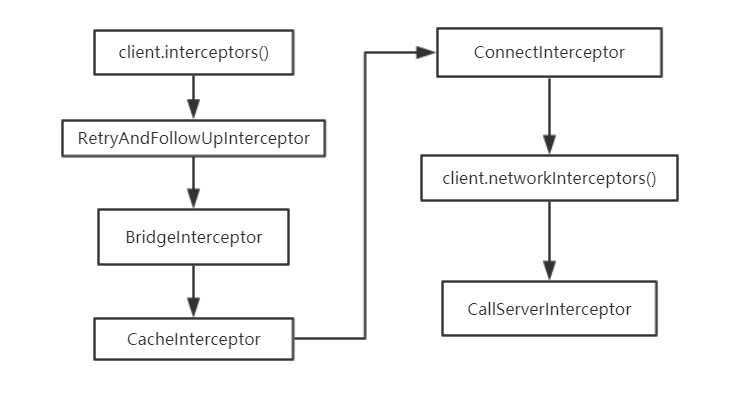@universal
2018-10-30T08:07:40.000000Z
字数 9395
阅读 321
Are you OK ? OK了解下
源码分析
简介
先简单介绍下Okhttp的用法吧:
直接从官网摘的:
OkHttpClient client = new OkHttpClient();String run(String url) throws IOException {Request request = new Request.Builder().url(url).build();Response response = client.newCall(request).execute();return response.body().string();}
这是同步的方式,异步就不放了。可以看到里面其实很关键的几个变量或者方法:OkHttpClient、Request、Response、newCall(),newCall其实返回的是一个Call对象,所以OK实际上也就是由这几个关键类构造起来的,为外部提供接口调用。
其他一些OK的详细用法,就不在这里讲了,这篇主要串一下OK的工作原理。
Loading.......
入口
先看下OkhttpClient这个类,它实现了Call.Factory接口,是构建call对象的关键。
public class OkHttpClient implements Cloneable, Call.Factory, WebSocket.Factory {public OkHttpClient() {this(new Builder());}@Override public Call newCall(Request request) {return RealCall.newRealCall(this, request, false /* for web socket */);}}
Builder是OkHttpClient中的静态内部类,主要是对一些参数进行初始化,比如说dispatcher等。
//OkHttpClient.Builderpublic Builder() {dispatcher = new Dispatcher();protocols = DEFAULT_PROTOCOLS;//协议connectionSpecs = DEFAULT_CONNECTION_SPECS;eventListenerFactory = EventListener.factory(EventListener.NONE);proxySelector = ProxySelector.getDefault();cookieJar = CookieJar.NO_COOKIES;socketFactory = SocketFactory.getDefault();hostnameVerifier = OkHostnameVerifier.INSTANCE;certificatePinner = CertificatePinner.DEFAULT;proxyAuthenticator = Authenticator.NONE;authenticator = Authenticator.NONE;connectionPool = new ConnectionPool();dns = Dns.SYSTEM;followSslRedirects = true;followRedirects = true;retryOnConnectionFailure = true;connectTimeout = 10_000;readTimeout = 10_000;writeTimeout = 10_000;pingInterval = 0;}
OkhttpClient中的newCall方法返回了一个realCall对象。我们这里先从同步的方式入手:
final class RealCall implements Call {static RealCall newRealCall(OkHttpClient client, Request originalRequest, boolean forWebSocket) {RealCall call = new RealCall(client, originalRequest, forWebSocket);call.eventListener = client.eventListenerFactory().create(call);return call;}@Overridepublic Response execute() throws IOException {synchronized (this) {if (executed) throw new IllegalStateException("Already Executed");executed = true;}captureCallStackTrace();eventListener.callStart(this);try {client.dispatcher().executed(this);Response result = getResponseWithInterceptorChain();if (result == null) throw new IOException("Canceled");return result;} catch (IOException e) {eventListener.callFailed(this, e);throw e;} finally {client.dispatcher().finished(this);}}}
再看其调用的excute()方法,先同步保证当前call对象只能被执行一次。然后调用dispatcher().executed(this),做一些准备工作。
调用getResponseWithInterceptorChain();来实际执行请求并且获取实际Http返回结果,最后调用dispatcher()通知请求结束。
//Dispatchersynchronized void executed(RealCall call) {runningSyncCalls.add(call);}
runningSyncCalls是一个双向队列,存储的是正在执行的同步的RealCall对象。
核心
//RealCallResponse getResponseWithInterceptorChain() throws IOException {// Build a full stack of interceptors.List<Interceptor> interceptors = new ArrayList<>();interceptors.addAll(client.interceptors());interceptors.add(retryAndFollowUpInterceptor);interceptors.add(new BridgeInterceptor(client.cookieJar()));interceptors.add(new CacheInterceptor(client.internalCache()));interceptors.add(new ConnectInterceptor(client));if (!forWebSocket) {interceptors.addAll(client.networkInterceptors());}interceptors.add(new CallServerInterceptor(forWebSocket));Interceptor.Chain chain = new RealInterceptorChain(interceptors, null, null, null, 0,originalRequest, this, eventListener, client.connectTimeoutMillis(),client.readTimeoutMillis(), client.writeTimeoutMillis());return chain.proceed(originalRequest);}
Interceptor 这个东西不仅仅是仅仅起了拦截请求的功能,它是OK的核心,把实际的网络请求、IO、缓存、透明压缩等功能都统一了起来,每一个功能都只是一个 Interceptor,它们再连接成一个 Interceptor.Chain,环环相扣,最终圆满完成一次网络请求。

可以看到上面代码,责任链的顺序:
1. 在配置OkhttpClient时设置的interceptor(自定义的interceptor);
2. 负责失败重试和重定向的拦截器;
3. 负责把用户构造的请求转换为发送到服务器的请求、把服务器返回的网络响应转换为用户响应的 BridgeInterceptor;
4. 负责请求的缓存,包括读取和写入;
5. 负责和服务器建立连接的 ConnectInterceptor;
6. 配置OkHttpClient时设置的 networkInterceptors;
7. 负责向服务器发送请求数据、从服务器读取响应数据的 CallServerInterceptor。
简单分析下:
1)这里功能虽然复杂,但是最后一个功能一定是负责和服务器进行实际通讯的,关于缓存、重定向之类都是需要在之前设置的。
2)Request通过这个责任链转换为Response, 而每个interceptor都可以独立的返回一个response,交由上层处理。
3)上层链的proceed方法 调用下层的intercept方法执行处理逻辑并继续去调用下层链的proceed,并返回response。层层嵌套,从而执行完整个责任链。这里逻辑的总控在类 RealInterceptorChain 中,大家可以下去仔细看下。
4)这种责任链模式将实际的网络请求操作逻辑给隔离,脱离RealCall,简化了各个部分负责的功能,优雅的实现了最终的需求。
其实这个责任链特别像计网中的分层,有木有! 下层向上层传递数据。
Interceptor
public final class ConnectInterceptor implements Interceptor {public final OkHttpClient client;public ConnectInterceptor(OkHttpClient client) {this.client = client;}@Override public Response intercept(Chain chain) throws IOException {RealInterceptorChain realChain = (RealInterceptorChain) chain;Request request = realChain.request();StreamAllocation streamAllocation = realChain.streamAllocation();// We need the network to satisfy this request. Possibly for validating a conditional GET.boolean doExtensiveHealthChecks = !request.method().equals("GET");HttpCodec httpCodec = streamAllocation.newStream(client, chain, doExtensiveHealthChecks);RealConnection connection = streamAllocation.connection();return realChain.proceed(request, streamAllocation, httpCodec, connection);}}
可以看到,建立连接其实就是根据StreamAllocation创建了一个HttpCodec对象和RealConnection对象,httpcodec主要是对http请求进行编码和对响应进行解码,HttpCodec的两个实现类Http2Codec、Http1Codec,很明显是针对Http/1.1 和Http/2版本。
StreamAllocation主要是用来协调Connections、Streams、Calls三个实体类之间的关系。大致上的逻辑就是寻找合适的realconnection,利用 RealConnection 的输入输出(BufferedSource 和 BufferedSink)创建 HttpCodec对象。
比如这样:(只截取了一小段)
RealConnection resultConnection = findHealthyConnection(connectTimeout, readTimeout,writeTimeout, pingIntervalMillis, connectionRetryEnabled, doExtensiveHealthChecks);HttpCodec resultCodec = resultConnection.newCodec(client, chain, this);
再看看CallServerInterceptor
public final class CallServerInterceptor implements Interceptor {private final boolean forWebSocket;@Override public Response intercept(Chain chain) throws IOException {RealInterceptorChain realChain = (RealInterceptorChain) chain;HttpCodec httpCodec = realChain.httpStream();StreamAllocation streamAllocation = realChain.streamAllocation();RealConnection connection = (RealConnection) realChain.connection();Request request = realChain.request();httpCodec.writeRequestHeaders(request);if (HttpMethod.permitsRequestBody(request.method()) && request.body() != null) {CountingSink requestBodyOut =new CountingSink(httpCodec.createRequestBody(request, contentLength));BufferedSink bufferedRequestBody = Okio.buffer(requestBodyOut);request.body().writeTo(bufferedRequestBody);bufferedRequestBody.close();}httpCodec.finishRequest();if (responseBuilder == null) {responseBuilder = httpCodec.readResponseHeaders(false);}Response response = responseBuilder.request(request).handshake(streamAllocation.connection().handshake()).sentRequestAtMillis(sentRequestMillis).receivedResponseAtMillis(System.currentTimeMillis()).build();if (forWebSocket && code == 101) {response = response.newBuilder().body(Util.EMPTY_RESPONSE).build();} else {response = response.newBuilder().body(httpCodec.openResponseBody(response)).build();}return response;}}
这里只挑出了核心代码,省略了一些监听回调和检查代码。
可以看到它的大致流程:
1. 通过httpcodec写入request header
2. 如果request body不为空,则发送到服务器
3. 读取responseHeader,构建Response
4. 如果response body不为空,则加入response中
这4步的核心都是由HttpCodec完成,HttpCodec的底层又是通过Okio,而Okio实际上还是用的Socket(socket逻辑实现在RealConnection中)。这里具体的逻辑就不分析了,有兴趣的童鞋可以去了解下。
经过上面的同步请求execute后,我们就能拿到返回的Response。
注意:响应的其他部分可以随意获取,但是response.body必须通过数据流的方式来进行访问(ok也提供了 body.string() 和 bytes() 这样的方法将流内的数据一次性读取完毕)。响应的 body 被封装到 ResponseBody 类中,该类主要有两点需要注意:
(1)每个 body 只能被消费一次,多次消费会抛出异常;
(2)body 必须被关闭,否则会发生资源泄漏;
异步
//RealCall@Override public void enqueue(Callback responseCallback) {synchronized (this) {if (executed) throw new IllegalStateException("Already Executed");executed = true;}captureCallStackTrace();eventListener.callStart(this);client.dispatcher().enqueue(new AsyncCall(responseCallback));}//Dispatchersynchronized void enqueue(AsyncCall call) {if (runningAsyncCalls.size() < maxRequests && runningCallsForHost(call) < maxRequestsPerHost){runningAsyncCalls.add(call);executorService().execute(call);} else {readyAsyncCalls.add(call);}}public synchronized ExecutorService executorService() {if (executorService == null) {//核心线程数为0,当线程空闲时只能活60秒,不存储元素的阻塞工作队列executorService = new ThreadPoolExecutor(0, Integer.MAX_VALUE, 60, TimeUnit.SECONDS,new SynchronousQueue<Runnable>(), Util.threadFactory("OkHttp Dispatcher", false));}return executorService;}
可以看到异步enqueue()方法主要是通过dispatcher来执行,如果队列runningAsyncCalls当前还能执行一个并发请求(具体的判断标准:即正在执行的异步队列中Call对象个数小于maxRequests(64)并且执行队列中的同一个host对应的Call对象个数小于maxRequestsPerHost(5)的时候),则调用executorService立即执行,可以看到这个executorService就是一个可缓存线程池。否则 将任务加入队列readyAsyncCalls,等待正在执行的Call请求的完成,调用promoteCalls,将call请求加入running状态中。
final class AsyncCall extends NamedRunnable {private final Callback responseCallback;AsyncCall(Callback responseCallback) {super("OkHttp %s", redactedUrl());this.responseCallback = responseCallback;}String host() { return originalRequest.url().host(); }Request request() { return originalRequest; }RealCall get() { return RealCall.this; }@Override protected void execute() {boolean signalledCallback = false;try {Response response = getResponseWithInterceptorChain();if (retryAndFollowUpInterceptor.isCanceled()) {signalledCallback = true;responseCallback.onFailure(RealCall.this, new IOException("Canceled"));} else {signalledCallback = true;responseCallback.onResponse(RealCall.this, response);}} catch (IOException e) {if (signalledCallback) {// Do not signal the callback twice!Platform.get().log(INFO, "Callback failure for " + toLoggableString(), e);} else {eventListener.callFailed(RealCall.this, e);responseCallback.onFailure(RealCall.this, e);}} finally {client.dispatcher().finished(this);}}}
上面的AsyncCall 是RealCall中的一个内部类,它实现了Runnable接口,所以可以直接提交给线程池执行,这里的run方法在父类NamedRunnable 中,内部其实调用的还是子类的execute方法,因此这里获取response的逻辑还是通过getResponseWithInterceptorChain责任链来进行的,最后通过接口回调responseCallback将响应发回去。注意这里是没有做线程切换的,所以想要UI更新的童鞋注意了。
Last
本篇只是简单的介绍了ok的工作流程,里面详细的工作机制,比如socket连接池、缓存策略等,只能期待下一篇了。
